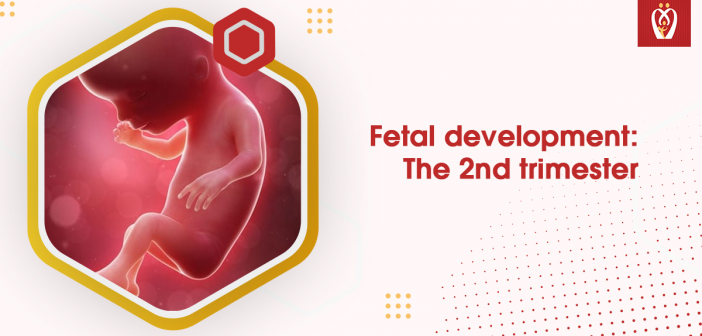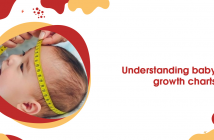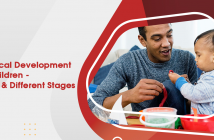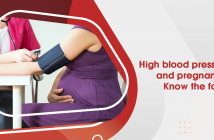Fetal development: The 2nd trimester
The 2nd trimester lasts from weeks 13 to 28. This stage of pregnancy is the most comfortable for many women. Morning sickness and fatigue fade, leaving you feeling more energized and like your old self.
Your baby may begin to appear more real as your pregnancy progresses. Your baby was a cluster of cells two months ago and now has working organs, nerves, and muscles. Check out this weekly calendar of events to see what happens during the second trimester. Remember that all measurements are approximations.
Before we begin, we would like to introduce you to the Nurturey PinkBook. Nurturey’s PinkBook is a ‘digital complement’ to the NHS red book. Pregnant women or parents can use the PinkBook to access their child’s health records, see upcoming health checkups, and receive trusted information directly from the NHS relevant to their stage in the parenting or pregnancy journey. If you have pregnancy concerns, you can instantly book an appointment with your GP using the Nurturey pregnancy app. Also, you can schedule appointments, reorder prescriptions, and message your GP.
Now let’s dive in!
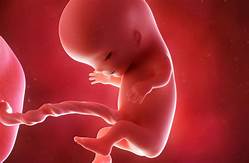
Week 13: Urine formation | pregnancy
Your baby starts making urine and releases it into the surrounding amniotic fluid 13 weeks into your pregnancy or 11 weeks after conception. Your unborn baby also starts swallowing amniotic fluid.
The baby’s skeleton hardens, especially the skull and long bones. Your baby’s skin is still thin and translucent, but it will thicken with time.
Week 14: The baby’s sex begins to unfold
Your baby’s neck becomes more defined 14 weeks into your pregnancy or 12 weeks after conception. In your baby’s spleen, red blood cells are forming. Your baby’s gender gets revealed this week or in the coming weeks.
Your baby may be nearly 3 1/2 inches (87 millimeters) long from crown to rump and weigh about 1 1/2 ounces by now (45 grams).
Week 15: The baby’s scalp pattern develops
Your baby is quickly growing at 15 weeks of pregnancy or 13 weeks after conception. Bone formation is continuing and will soon be visible on ultrasound images. Your baby’s scalp hair pattern is also taking shape.
Week 16: Baby’s eyes move
Your baby’s head is erect 16 weeks into your pregnancy or 14 weeks after conception. The eyes can move slowly. The ears are nearly in their final position. Your baby’s skin is thickening. The coordination of your baby’s limb movements improves and is detectable during ultrasound exams. However, these movements are still too subtle for you to notice.
Your baby may be more than 4 1/2 inches (120 millimeters) long from crown to rump and weigh close to 4 ounces at this point (110 grams).
Week 17: The baby’s toenails grow
Toenails begin to grow 17 weeks into your pregnancy or 15 weeks after conception. Your baby becomes more active, rolling and flipping in the amniotic sac. Every day, the baby’s heart pumps approximately 100 pints of blood.
Week 18: The baby starts to hear
Your baby’s ears begin to stand out from the sides 18 weeks into your pregnancy or 16 weeks after conception and start to hear sounds. The eyes start to turn forward. Your baby’s digestive system has begun to function.
Your baby may be 5 1/2 inches (140 millimeters) long from crown to rump and weigh 7 ounces at this point (200 grams).
Week 19: The baby grows a protective coating
Growth slows after 19 weeks of pregnancy or 17 weeks after conception. Vernix caseosa, a greasy, cheese-like coating, begins to cover your baby. The vernix caseosa protects your baby’s delicate skin from abrasions, chapping, and hardening caused by amniotic fluid exposure. The uterus and vaginal canal start developing in females.
Week 20: The halfway point
You may be able to feel your baby’s movements halfway through your pregnancy or 18 weeks after conception (quickening). Your baby is sleeping and waking up regularly. Noises or your movements may startle the baby.
Your baby may be 6 1/3 inches (160 millimeters) long from crown to rump and weigh more than 11 ounces by now (320 grams).
Week 21: Baby can suck the thumb
At 21 weeks of pregnancy or 19 weeks after conception, the lanugo, a fine, downy hair, completely covers your baby. The lanugo helps in the retention of the vernix caseosa on the skin.
Your baby’s sucking reflex develops, allowing the unborn to suck the thumb.
Week 22: The baby’s hair appears
Your baby’s brows and hair are visible 22 weeks into your pregnancy or 20 weeks after conception. Brown fat, the site of heat production, is also forming. The testes have begun to drop in boys.
Your baby may be 7 1/2 inches (190 millimeters) long from crown to rump and weigh about 1 pound at this point (460 grams).
Week 23: The formation of fingerprints and footprints
Your baby begins to have rapid eye movements 23 weeks into your pregnancy or 21 weeks after conception. Ridges form in the palms of the hands and soles of the feet, laying the groundwork for fingerprints and footprints.
Your baby may start hiccuping, resulting in jerking movements.
Week 24: The baby’s skin has wrinkles
Because of visible blood in the capillaries, your baby’s skin is wrinkled, translucent, and pink to red 24 weeks into your pregnancy or 22 weeks after conception. (pregnancy)
Your baby may be 8 inches (210 millimeters) long from crown to rump and weigh more than 1 1/3 pounds by now (630 grams).
Week 25: The baby responds to your voice
Your baby may be able to respond to familiar sounds, such as your voice, with movement after 25 weeks of pregnancy or 23 weeks after conception.
Your baby spends most of the sleep time in rapid eye movement (REM), which occurs when the eyes move quickly, even when the eyelids are closed. (pregnancy)
Week 26: Baby’s lungs develop
At 26 weeks of pregnancy or 24 weeks after conception, your baby’s lungs start to produce surfactant. It is a substance that allows the air sacs in the lungs to inflate and prevents them from collapsing and sticking together when deflating.
Your baby may be 9 inches (230 millimeters) long from crown to rump and weigh nearly 2 pounds at this point (820 grams).
Week 27: 2nd-trimester ends
The second trimester concludes this week. Your baby’s nervous system is still maturing at 27 weeks or 25 weeks after conception. Your baby also gains fat, which will smooth out the unborn’s skin.

